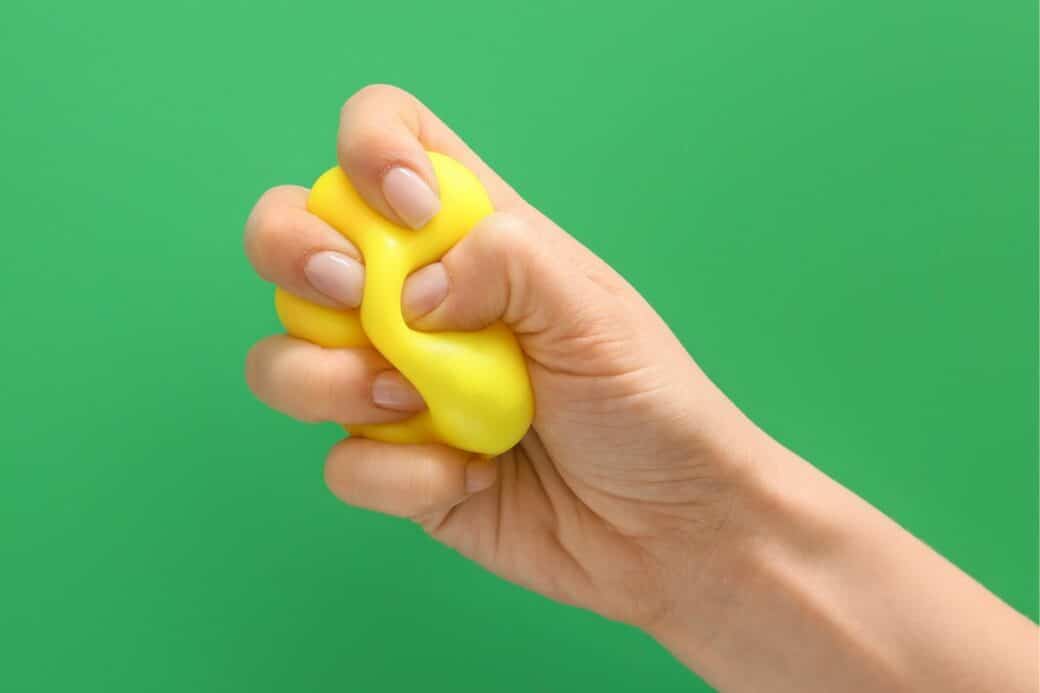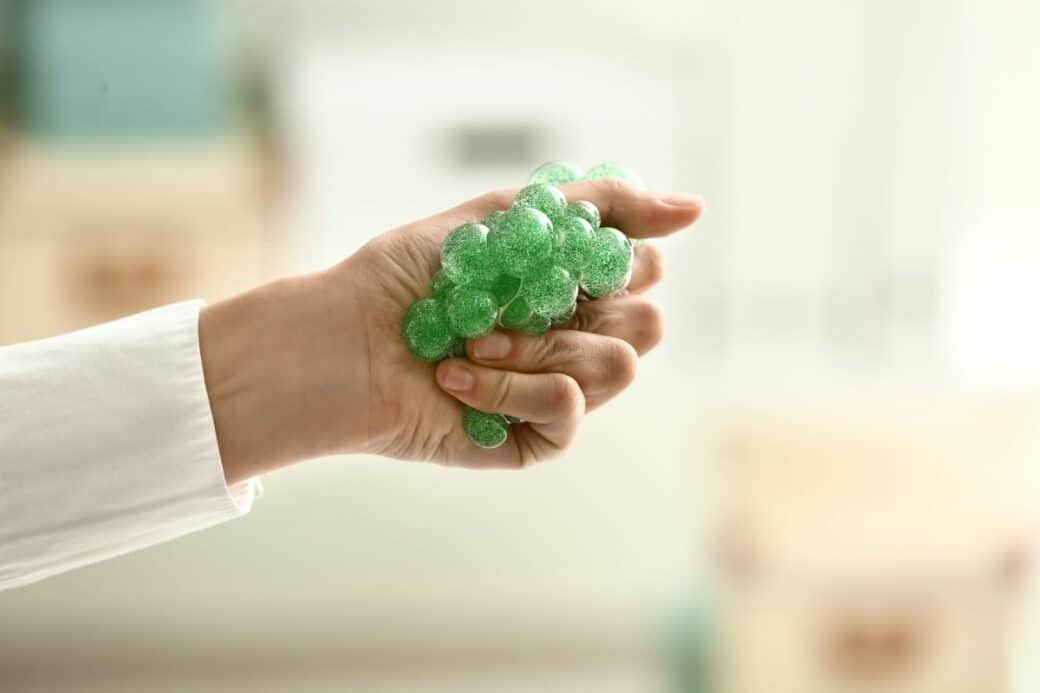Have you ever wondered if stress balls can actually help improve your grip strength? It’s a common misconception that these squishy toys are only used to relieve stress. In reality, they have the potential to do much more. By incorporating stress balls into your fitness routine, you may be able to enhance your grip strength and overall physical performance. In this article, we’ll explore the science behind stress balls, their potential benefits, and how to effectively use them to boost your fitness. So grab a stress ball and get ready to strengthen not just your hands, but your entire body.

Do Stress Balls Increase Grip Strength: Understanding Grip Strength
What is Grip Strength
Grip strength refers to the measure of the force exerted by the muscles in your hand and forearm to hold or grasp an object. It is an essential component of overall fitness as it plays a vital role in everyday activities such as carrying groceries, opening jars, and performing various exercises. Grip strength is commonly measured using a dynamometer, a device specifically designed for this purpose.
Why is Grip Strength Important for Overall Fitness
Having strong grip strength is crucial for overall fitness and functionality. It enables you to perform a wide range of activities with ease and efficiency. A strong grip not only enhances your performance in activities like weightlifting, rock climbing, and racquet sports but also improves your posture and reduces the risk of injuries. Furthermore, grip strength has been linked to various health benefits, including improved cardiovascular health and reduced mortality rates.
Factors Affecting Grip Strength
Several factors can affect grip strength, including age, gender, and physical condition. As we age, our grip strength tends to decrease due to muscle loss and decreased flexibility. Men generally have stronger grip strength than women, primarily due to differences in muscle mass and hormone levels. Additionally, certain medical conditions, such as arthritis and carpal tunnel syndrome, can negatively impact grip strength. It is essential to understand these factors to effectively improve and maintain grip strength.
Introduction to Stress Balls
What are Stress Balls
Stress balls are small, malleable objects that are designed to be squeezed in the palm of your hand. They are commonly made of foam or gel-like materials and are often filled with substances like sand or rice. Stress balls come in various shapes, sizes, and densities, allowing users to choose the one that suits their preferences and needs. These portable and affordable tools have gained popularity for their effectiveness in stress relief and grip strength enhancement.
Different Types of Stress Balls
There are several types of stress balls available on the market today. Traditional stress balls are typically round or oval-shaped and made of foam or rubber. They provide a comfortable and flexible surface for squeezing, promoting relaxation and stress reduction. Another type is the Chinese stress ball, also known as Baoding balls. These metal balls contain a small chime inside and are used for therapeutic purposes, including hand and finger exercises, meditation, and relaxation techniques.
The Design and Material of Stress Balls
Stress balls come in various designs and materials, each offering unique benefits. Foam stress balls are lightweight, soft, and provide a gentle resistance when squeezed. They are ideal for individuals with grip strength limitations or those seeking stress relief without exerting excessive force. Gel stress balls, on the other hand, are firmer and offer a more challenging resistance. These balls are beneficial for those aiming to improve their grip strength and engage their hand and forearm muscles more intensively. The choice of stress ball material depends on individual preferences and fitness goals.
Use of Stress Balls for Stress Relief
How Stress Balls Help in Stress Relief
Stress balls are widely recognized for their ability to alleviate stress and promote relaxation. When you squeeze a stress ball, the repetitive motion activates and stimulates the nerves in your hand and forearm. This action triggers the release of endorphins, the body’s natural “feel-good” hormones, which induce a sense of calmness and relaxation. By focusing on the rhythmic squeezing and releasing motion, stress balls redirect your attention away from stressful thoughts and promote a meditative-like state.
Psychological Benefits of Using Stress Balls
In addition to stress relief, using stress balls provides several psychological benefits. The repetitive squeezing and releasing motion can help reduce symptoms of anxiety and improve overall mood. The physical act of squeezing a stress ball also helps to relieve muscle tension and promote a sense of physical and mental relaxation. Regular use of stress balls as a stress management tool can enhance self-awareness, mindfulness, and emotional well-being.
Physical Benefits of Using Stress Balls
While stress balls are primarily associated with stress relief, they also offer significant physical benefits. Regular use of stress balls can strengthen the muscles in the hand, fingers, and forearm. The resistance provided by the stress ball engages these muscles, improving grip strength and promoting overall hand and arm functionality. Furthermore, using stress balls can help relieve symptoms of repetitive strain injuries, such as carpal tunnel syndrome, and improve hand dexterity and coordination.
Connecting Stress Balls and Grip Strength
Theory Behind Grip Strength Enhancement With Stress Balls
The theory behind using stress balls to enhance grip strength lies in the principle of muscle adaptation. By repeatedly squeezing and releasing stress balls, the muscles in your hand, fingers, and forearm are subjected to resistance, causing them to adapt and become stronger over time. This process is similar to exercising any other muscle group in your body. Consistent use of stress balls challenges and conditions these muscles, leading to increased grip strength.
Scientific Studies Linking Stress Balls and Grip Strength
Several scientific studies have explored the relationship between stress balls and grip strength enhancement. One study conducted by researchers at the University of Queensland found that a 12-week handgrip exercise program using stress balls significantly improved grip strength in older adults. Another study published in the Journal of Hand Therapy showed that using stress balls as part of a comprehensive hand therapy program led to improvements in grip strength, hand function, and pain relief in individuals with hand osteoarthritis.
How Exercise With Stress Balls Improves Grip Strength
Exercise with stress balls involves performing a variety of hand and forearm exercises using the stress ball as resistance. By incorporating specific grips, squeezes, and rotations, these exercises target the muscles responsible for grip strength. Over time, the repetitive motions and resistance provided by stress balls help build muscle endurance, increase muscle fiber recruitment, and improve overall grip strength. Regular and structured exercise routines are essential for maximizing the benefits of stress ball workouts.
How to Use Stress Balls for Improve Grip Strength
Correct Usage of Stress Balls for Grip Strength Exercise
To effectively improve grip strength using stress balls, it is crucial to use them correctly. Start by selecting a stress ball that is comfortable to hold and provides an appropriate level of resistance. Begin with a warm-up, such as stretching exercises for your hands and fingers, to prepare the muscles for the workout. Then, perform various grip exercises, including simple squeezing, finger extensions, and wrist rotations, using the stress ball as resistance. Gradually increase the intensity and duration of the exercises as your grip strength improves.
Different Exercises to Improve Grip Strength using Stress Balls
There are numerous exercises that you can incorporate into your grip strength training routine using stress balls. Some examples include:
- Squeeze and Hold: Squeeze the stress ball as hard as you can and hold for 10-15 seconds before releasing. Repeat for multiple sets.
- Finger Extensions: Place the stress ball in the palm of your hand and press your fingers down into the ball, then extend your fingers outward. Repeat for multiple repetitions.
- Wrist Rotations: Hold the stress ball and rotate your wrist in a circular motion, both clockwise and counterclockwise. Perform for a set number of repetitions.
- Thumb Press: Place the stress ball between your thumb and fingers and press your thumb into the ball. Hold for a few seconds and release. Repeat for multiple sets.
Perseverance and Regularity in Exercises
Consistency plays a vital role in improving grip strength using stress balls. It is important to incorporate grip strength exercises into your fitness routine regularly, ideally at least two to three times per week. Gradually increase the intensity and duration of your workouts as you progress. It is normal to experience muscle soreness initially, but with perseverance and regularity, you will see improvements in your grip strength over time. Remember to listen to your body and rest when needed to prevent overexertion or injury.
Factors Impacting Effectiveness of Stress Balls on Grip Strength
Size of the Stress Ball
The size of the stress ball can impact its effectiveness in improving grip strength. Smaller stress balls may require greater finger and hand strength to squeeze, making them more suitable for individuals with already-developed grip strength. Conversely, larger stress balls offer a more substantial surface area to hold, allowing for a softer grip and less resistance. Choosing a stress ball size that suits your current grip strength level and gradually progressing to smaller sizes as you improve can optimize your grip strength training.
Material of the Stress Ball
The material of the stress ball also plays a role in its effectiveness for grip strength improvement. Foam stress balls tend to be softer and provide less resistance, making them suitable for beginners or individuals with lower grip strength. Gel stress balls, on the other hand, are denser and offer more resistance, making them more challenging and beneficial for advanced users aiming to intensify their grip strength workouts. Consider your current grip strength level and goals when selecting the material of your stress ball.
Duration and Frequency of Exercise
Both the duration and frequency of exercise with stress balls can impact the effectiveness of grip strength improvement. It is recommended to start with shorter sessions, around 10-15 minutes, and gradually increase the duration as your grip strength improves. Aim to exercise with stress balls at least two to three times per week to stimulate muscle growth and increase grip strength effectively. However, avoid overtraining and listen to your body’s signals to prevent fatigue or potential injuries.
Measuring Improvement in Grip Strength

Tools to Measure Grip Strength
Various tools can be used to measure grip strength accurately. A dynamometer, a handheld device specifically designed for this purpose, is the most common and reliable tool. It measures the maximum force exerted during a grip, providing a quantitative measurement of grip strength. There are both analog and digital dynamometers available, with digital variants offering additional features such as data storage and analysis. These tools allow for consistent and objective measurements, enabling you to track your progress effectively.
Frequency of Measurement
The frequency at which you measure your grip strength depends on your goals and personal preferences. For individuals aiming to track their progress consistently, measuring grip strength once every two to four weeks may be sufficient. This timeframe allows for adequate recovery and potential gains in grip strength to be noticeable. However, if you are specifically targeting grip strength improvements or participating in a structured grip strength training program, more frequent measurements, such as once a week, can provide valuable feedback and motivation.
Milestones to Look for in Grip Strength Enhancement
Enhancing grip strength is a gradual process, and it is important to recognize and celebrate milestones along the way. Individual milestones may vary depending on starting grip strength levels and personal goals. Some common milestones to look for in grip strength enhancement include:
- Consistent Improvement: Noticeable increases in grip strength over time, as measured by a dynamometer or similar tool.
- Increased Endurance: The ability to maintain a strong grip for an extended duration without experiencing fatigue or discomfort.
- Functional Improvement: Enhanced performance in activities requiring grip strength, such as weightlifting, carrying heavy objects, or participating in sports.
- Pain Reduction: Decreased pain or discomfort in the hand, wrist, or forearm during daily activities or specific exercises.
Safety Measures while Using Stress Balls for Grip Strength
Potential Risks
Using stress balls for grip strength exercises is generally safe. However, it is essential to be aware of potential risks to prevent injuries or exacerbation of existing conditions. Overexertion can lead to muscle strains or joint pain, so it is important to start with light resistance and gradually increase over time. Individuals with certain medical conditions, such as carpal tunnel syndrome, arthritis, or tendonitis, should consult with a healthcare professional before incorporating stress ball exercises into their routine. Additionally, proper form and technique are crucial to prevent unnecessary strain on the hand and forearm muscles.
Precautions while Exercising
To minimize the risk of injury and maximize the benefits of stress ball exercises, it is important to take certain precautions. Warm-up your hands and fingers with gentle stretches before starting the exercises to increase blood flow and reduce the risk of muscle strains. Maintain proper form and avoid excessive force or sudden movements that may strain the muscles. If you experience any pain, discomfort, or inflammation during or after exercising with stress balls, it is advisable to rest and consult a healthcare professional if necessary.
When to Stop Using Stress Balls for Grip Strength
There may be instances when it is advisable to discontinue or modify the use of stress balls for grip strength improvement. If you experience severe pain, swelling, or limited range of motion in your hand, wrist, or forearm, it is important to seek medical attention and temporarily stop using stress balls until the issue is resolved. Additionally, if you have a pre-existing condition that worsens or causes discomfort during stress ball exercises, it may be necessary to assess whether alternative grip strength training methods are more suitable. Always prioritize your safety and consult with a healthcare professional if you have any concerns.
Stress Balls vs Other Tools for Grip Strength Improvement
How Stress Balls Compare to Hand Grippers
Hand grippers are another popular tool used for grip strength improvement. Unlike stress balls, hand grippers are specifically designed to target and strengthen the muscles involved in grip strength. Grippers typically consist of two handles connected by a spring or coil, which provide variable resistance. While stress balls primarily engage the forearm and finger flexor muscles, hand grippers primarily target the finger extensor muscles. Both stress balls and hand grippers can be effective for grip strength improvement, and incorporating both into your training routine may offer a well-rounded approach.
Benefits and Drawbacks of Stress Balls for Grip Strength
Stress balls offer several benefits for grip strength improvement. They provide a portable and convenient option for exercise, allowing you to perform grip strength workouts anywhere, anytime. Stress balls are also versatile and can be used for stress relief and hand therapy in addition to grip strength training. However, stress balls may not offer the same level of targeted resistance as specialized grip strength tools like hand grippers. The level of resistance provided by stress balls may be limiting for individuals with advanced grip strength capabilities seeking more intense workouts.
Suitability of Stress Balls for Different User Profiles
Stress balls can be suitable for individuals of various fitness levels and goals. They are particularly beneficial for beginners or those with lower grip strength looking to improve their overall hand and forearm strength. Stress balls offer a gentle introduction to grip strength exercises without placing excessive strain on the muscles and joints. Additionally, individuals seeking stress relief, improved dexterity, or hand rehabilitation can also benefit from incorporating stress balls into their routine. Advanced users with higher grip strength capabilities may find stress balls less challenging and may require additional specialized grip strength tools to further progress.
Conclusion: Do Stress Balls Increase Grip Strength?
Summary of Findings
Stress balls can indeed increase grip strength when used correctly and consistently. The repetitive squeezing and releasing motion involved in stress ball exercises stimulate and strengthen the muscles in the hand, fingers, and forearm, leading to improved grip strength over time. Scientific studies have shown positive correlations between the use of stress balls and grip strength enhancement, particularly in older adults and individuals with hand osteoarthritis. Stress balls offer not only physical benefits but also psychological benefits such as stress relief and relaxation.
Practical Tips for those aiming to Improve Grip Strength using Stress Balls
To make the most of your grip strength training with stress balls, consider the following tips:
- Choose a stress ball size and material that suits your current grip strength level and fitness goals.
- Start with lighter resistance and gradually increase the intensity and duration of your exercises as your grip strength improves.
- Incorporate a variety of grip exercises using stress balls, targeting different muscle groups in the hand and forearm.
- Prioritize consistency and regularity in your workouts to maximize the benefits of stress ball exercises.
- Listen to your body and rest when needed to prevent overexertion or injury.
What the Surge in Popularity of Stress Balls for Grip Strength Means for Fitness Enthusiasts
The increasing popularity of stress balls for grip strength improvement reflects a growing recognition of the importance of grip strength in overall fitness. As more individuals discover the benefits of incorporating stress balls into their workout routines, the availability and variety of stress ball options on the market continue to expand. This surge in popularity also highlights the need for comprehensive grip strength training programs and resources to help individuals achieve their fitness goals effectively. By embracing stress balls as a tool for grip strength enhancement, fitness enthusiasts can enhance their overall fitness and functionality while enjoying the added benefits of stress relief and relaxation.




